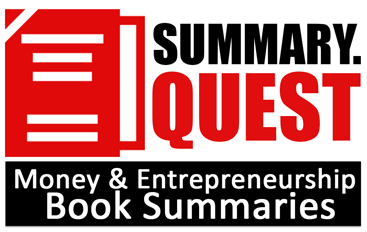Imagine turning complete strangers into eager buyers—effortlessly. $100M Leads by Alex Hormozi isn’t just another marketing book; it’s a proven playbook for multiplying your leads and skyrocketing your business. Whether you want to double, triple, or even 100x your conversions, this blueprint shows you exactly how. Today, we’re unlocking some of the secrets within its pages, revealing how to transform those icy-cold strangers into red-hot buyers, and equipping you with the tools to implement these strategies immediately. Prepare to revolutionize your lead game, let’s dive in.
Key Idea No. 1: How to Get Leads
Starting a business can feel overwhelming, but at its core, success comes down to one simple thing: customers. And how do you get customers? Through leads.

A lead is anyone who shows interest in your product or service. It could be someone who follows your social media page, signs up for a newsletter, or asks about your pricing. Leads are the lifeline of any business—without them, even the best product won’t sell.
Fortunately, generating leads doesn’t require luck, special talent, or a huge budget. The key is consistency and smart strategies. There are four proven ways to attract potential customers: warm outreach, posting free content, cold outreach, and paid advertising.
- Warm Outreach: Warm outreach is often overlooked because many assume business success must come from strangers or viral marketing. However, reaching out to people you already know—friends, family, old clients, or colleagues—can be a game-changer. A simple message or email explaining what you do can open doors. These people already trust you and are more likely to support you or refer others. This is a low-cost and effective way to get started.
- Free Content: Another way to attract leads is by posting free content. In today’s digital world, people spend hours scrolling through social media, watching videos, and reading blogs. Sharing helpful and engaging content, such as tips, tutorials, and behind-the-scenes insights, helps build trust and authority. Instead of pushing direct sales, content marketing focuses on educating and engaging potential customers. Over time, this strategy builds familiarity, leading to more inquiries and sales. Unlike one-time advertising efforts, valuable content continues to attract leads long after it’s posted.
- Cold Outreach: Cold outreach is another powerful method for generating leads. This involves reaching out to potential customers who don’t know you yet, either through direct messages, emails, or calls. While this can feel intimidating, the key is to provide genuine value instead of sending spammy sales pitches. The focus should be on how your product or service can solve a problem. Persistence is essential in cold outreach—expecting rejections but continuing to refine the approach will ultimately lead to success.
- Paid Advertisement: For businesses looking to scale quickly, paid advertising is one of the fastest ways to reach new customers. Platforms like Facebook, Instagram, Google, and YouTube allow businesses to target specific audiences based on interests, location, and behavior. When used strategically, paid ads can bring a steady flow of leads. However, simply spending money on ads without a clear message or offer won’t work. The most effective ads clearly present the problem, highlight why your solution is the best, and include a clear call to action. Starting with a small budget, testing different ads, and scaling up what works is the best way to make the most of paid advertising.
The most important factor in lead generation is consistency. None of these methods will deliver instant results, but taking daily actions, refining the approach, and learning from feedback will lead to steady progress. Over time, businesses gain a better understanding of their audience, improve their messaging, and close more deals. The skills developed in lead generation are valuable for life—no matter what industry a person enters, knowing how to attract leads provides control over success.
Key Idea No. 2: How to Create an Effective Lead Magnet

A lead magnet is a valuable resource that businesses offer for free in exchange for a potential customer’s contact information, usually an email address. It’s a way to attract the right audience, build trust, and eventually turn them into paying customers. However, not all lead magnets are effective. The real power of a lead magnet lies in how well it engages people and provides real value. Simply collecting emails or phone numbers won’t guarantee sales; the goal is to make people genuinely interested in what you offer.
To create an effective lead magnet, there’s a strategic seven-step process that businesses can follow. Each step plays an important role in making sure the lead magnet attracts the right audience, delivers real value, and motivates action.
- Identify a Specific Problem: The first step is to pick a small but important problem to solve. A lead magnet should be specific and focused rather than broad and vague. If it tries to cover too much, it won’t speak to anyone’s exact needs. Choosing a single, pressing issue that your ideal customer faces make it more appealing and useful.
- Decide on a Solution: Once the problem is clear, the next step is deciding how to solve it. There are a few proven approaches. One way is to reveal an issue the customer might not even know they have, such as a website speed test that shows how a slow site is affecting their sales. Another option is to offer a sample or trial of your product so they can experience its value firsthand. A third approach is to provide one useful step of a larger solution. For example, a business selling complete home renovation services might offer a free consultation on kitchen upgrades.
- Choose Right Delivery Method: Choosing the right delivery method is also important. A lead magnet can come in many forms, such as an eBook, video tutorial, free audit, consultation, software, or even a physical product sample. The format should match the problem being solved and be easy for the audience to consume. For instance, if you’re offering financial advice, a simple budgeting spreadsheet might be ideal. If you sell skincare products, a free sample makes more sense. The easier it is for people to access and benefit from your lead magnet, the more effective it will be.
- Craft a Tempting Title: Presentation plays a big role in attracting attention. A lead magnet needs a strong, compelling title. A weak, generic title like “Free Marketing Tips” won’t grab interest, but something like “The 3-Step Strategy That Tripled Our Sales in 30 Days” will create curiosity. Small wording tweaks can make a big difference in engagement. Testing different titles to see what resonates most with your audience is a smart move.
- Ensure Simplicity & Accessibility: Keeping it simple is another key factor. Even if a lead magnet offers great value, people won’t use it if it’s too complicated or time-consuming. The format should be easy to understand, mobile-friendly, and accessible in multiple formats (video, text, or audio) if possible. The smoother the experience, the higher the chances that potential customers will engage with it and take further action.
- Provide Genuine Value: A common mistake businesses make is holding back their best insights, fearing that giving too much for free will hurt sales. In reality, the more value you provide, the more trust you build. When people see how helpful your free content is, they’ll assume your paid products or services must be even better. The real reason people buy is not just for information but for implementation, guidance, and extra value. Sharing top-quality insights upfront makes a business look trustworthy and generous, which increases the likelihood of converting leads into customers.
- A Strong Call to Action: The final step in making a lead magnet successful is adding a clear call to action (CTA). After someone downloads or interacts with the lead magnet, they should immediately know what to do next. Whether it’s booking a call, making a purchase, or signing up for a service, the CTA should be direct and compelling. Creating urgency, exclusivity, or offering a special bonus can push people to take action quickly instead of delaying.
By following this strategy, businesses can transform simple lead collection into an effective engagement tool. Instead of spending a fortune on ads that barely convert, they can use a lead magnet to attract the right audience at a much lower cost while also building stronger relationships. When done right, a lead magnet isn’t just a way to gather contacts—it’s a powerful way to turn interested prospects into loyal customers.
Key Idea No. 3: How to Get Customers for Free
Imagine having a team of people promoting your business without paying them a salary. These people could be your customers, employees, other businesses, or even affiliates. They spread the word about your brand because they believe in it, creating a ripple effect that brings in new customers with minimal effort on your part. This is the power of leverage.

Leverage means doing more with less. Instead of reaching out to every potential customer yourself, you set up a system where others do it for you. There are four main types of “lead getters” who can help you bring in customers:
- Customers: Happy customers naturally tell their friends about your product.
- Employees: Your team can bring in new customers by recommending your business.
- Agencies: Some companies specialize in finding customers for businesses.
- Affiliates: Other businesses or individuals promote your products in exchange for a commission.
Once you understand how to use these lead getters, you can apply the concept to any business you start. Instead of exhausting yourself with ads, emails, and social media posts, you can let satisfied customers and strategic partners spread the word. This massively increases your reach and helps you attract customers effortlessly.
Of all the different types of lead getters out there, customer referrals hold a special place. People trust recommendations from friends and family more than any advertisement. A happy customer talking about your product carries more weight than even the most well-crafted marketing campaign.

Referred customers are not only easier to convert, but they also tend to spend more and stay loyal to your brand longer. Plus, they cost almost nothing to acquire since they come through word-of-mouth instead of paid advertising.
So, how do you unlock this potential and turn your existing customer base into a powerful referral engine? It’s not just about sitting back and hoping that people will spread the word; it requires a proactive approach and a focus on building strong customer relationships. If you want customers to promote your business, you have to give them a reason to. Here’s how:
- Deliver an Exceptional Product or Service: If your product isn’t great, people won’t recommend it. Make sure you exceed expectations so customers are excited to share their experiences.
- Manage Expectations Wisely: Don’t over-promise and under-deliver. Instead, surprise customers by giving them more value than they expected.
- Help Customers Get the Best Results: Offer support, resources, or tips to help them succeed with your product. When customers achieve their goals, they’ll want to tell others about it.
- Ask for Referrals: Many businesses miss out simply because they never ask. Make it easy for customers to refer others and consider offering incentives to encourage them.
By focusing on these strategies, you can build a network of people who bring in new customers for you. Instead of doing all the work yourself, you become the leader of a system that fuels continuous growth.
Getting an effective lead is the cornerstone of business success, but turning that lead into real results requires persistence and the ability to follow through. If you often find yourself starting projects but never finishing them, Finish What You Start is full of practical advice to help you overcome this challenge. Click here to uncover powerful strategies that will keep you focused and unstoppable.

Leave a Reply